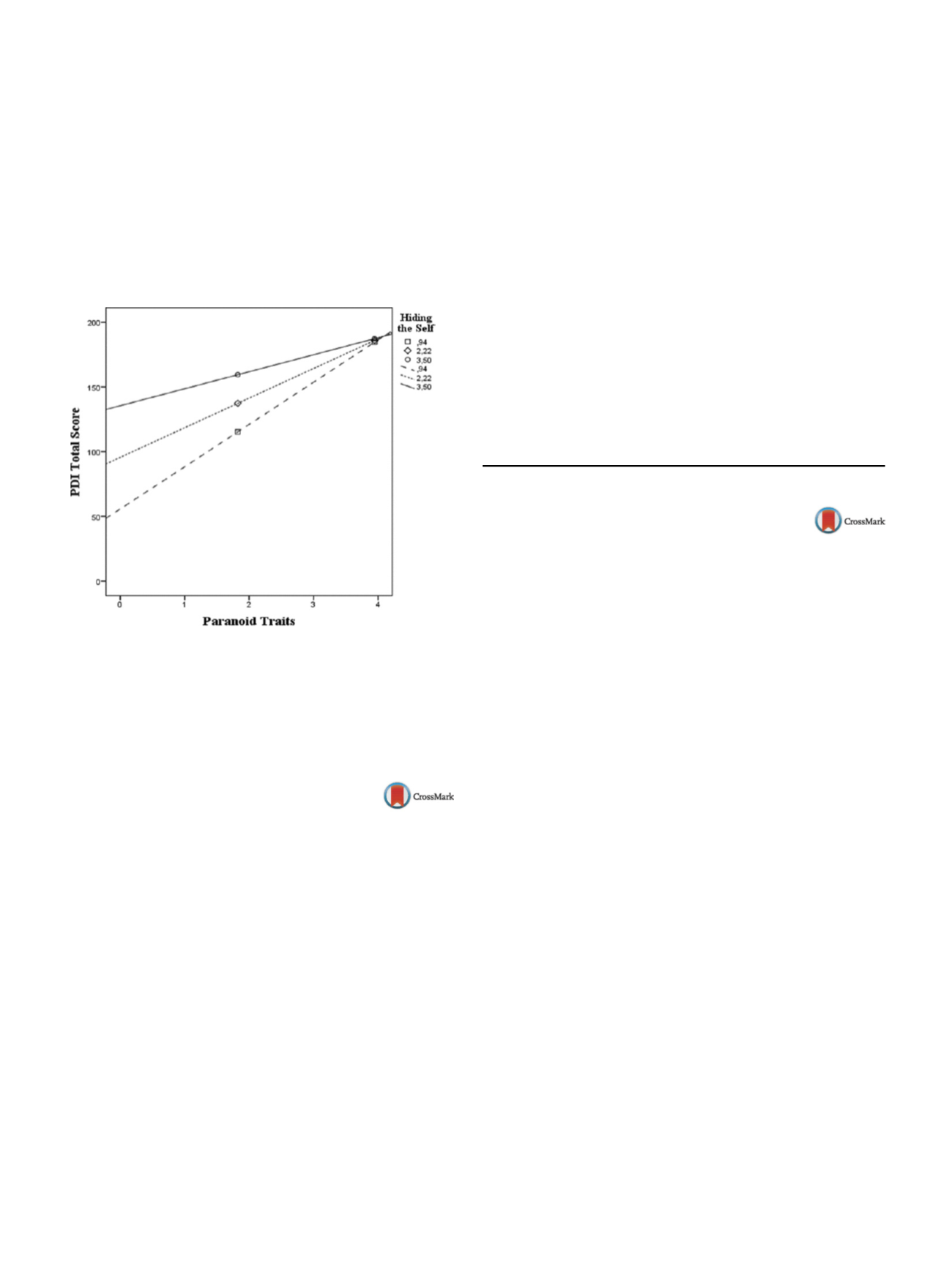

S748
25th European Congress of Psychiatry / European Psychiatry 41S (2017) S710–S771
noid traits and HS significantly interacted in influencing delusional
dimension severity
( Fig. 1 ).Low PA represents a trait affectivity of
sadness and lethargy whereas HS is closely related to the experi-
ence of shame. We speculate that lower levels of PA and higher
levels of HS may grasp the “asthenic” pole of Kretschmer’s “sensi-
tive character”.
Conclusion
The study findings suggest that the severity of delu-
sional ideation depends, at least in part, on a complex interplay
between specific affective and paranoid dispositions within per-
sonality. Delusion may constitute the superficial shell, which
develops from and cover inner affective vulnerabilities of person-
ality.
Fig. 1
Disclosure of interest
The authors have not supplied their decla-
ration of competing interest.
http://dx.doi.org/10.1016/j.eurpsy.2017.01.1387EV1058
The impact of interpersonal violence
in youth sport on adult
psychopathology
T. Vertommen
1 , 2 ,∗
, J. Kampen
3, N. Schipper-van Veldhoven
4,
K. Uzieblo
2, F. Van Den Eede
11
University of Antwerp, Collaborative Antwerp Psychiatric Research
Institute, Antwerp, Belgium
2
Thomas More University College, Applied Psychology, Antwerp,
Belgium
3
University of Antwerp, StatUA, Antwerp, Belgium
4
Windesheim University of Applied Sciences, Research Centre Human
Movement and Education, Zwolle, The Netherlands
∗
Corresponding author.
Introduction
A recent cohort study in the Netherlands and Bel-
gium showed that 38% of children experienced psychological
violence, 11% physical violence, and 14% sexual violence in sport
(Vertommen et al., 2016). This study aims to explore the long-term
consequences on anxiety, depression and somatic complaints in
adults who experienced psychological, physical or sexual violence
in the specific context of organized youth sport.
Methods
A web survey in a representative sample of adults, pre-
screened on having participated in organized sport before the age
of 18 (
n
= 4043) was conducted. In this sample, depression, anxi-
ety and somatic problems were assessed using the brief symptom
inventory. A generalized linear model was used to quantify the
impact of experiencing severe interpersonal violence in sport on
psychopathology.
Results
All three types of severe interpersonal violence (psy-
chological, physical and sexual) were significantly associated
with the total score and the subscales of the brief symptom
inventory. The effect remains significant after controlling for socio-
demographics, as well as disability, sexual orientation, adverse
childhood experiences outside sport, recent trauma and family his-
tory of psychological problems.
Conclusions
Experiencing interpersonal violence against in youth
sport is associated with mental health problems in adulthood. This
is an important finding to consider in child protection policy in
sport.
Disclosure of interest
The authors have not supplied their decla-
ration of competing interest.
http://dx.doi.org/10.1016/j.eurpsy.2017.01.1388e-Poster Viewing: Psychopharmacology and
pharmacoeconomics
EV1059
Chlorpromazine-induced lupus with
circulating anticoagulant. A case
report
W. Abbes
1 ,∗
, B. Imen
1, A. Hanene
2, S. Mouna
3, K. Kamilia
2,
B. Zouheir
2, M. Jawaher
11
Hédi Chaker University Hospital, Psychiatry “A”, Sfax, Tunisia
2
Faculty of Medicine of Sfax, Regional Pharmacovigilance Centre,
Sfax, Tunisia
3
Hedi Chaker University Hospital, Department of Internal Medicine,
Sfax, Tunisia
∗
Corresponding author.
The drug-induced lupus erythematosus (DILE) is an autoimmune
disorder caused by chronic use of certain drugs, including chlorpro-
mazine. Chlorpromazine-induced lupus associated to circulating
anticoagulant antibodies (CAC) would be even less frequent. Our
observation is an illustration of this association.
We report the case of Mrs. H., 33-year-old, without medical
or surgical history, who has been followed in psychiatry since
the age of 20 for bipolar disorder type 1. This patient was
initially stabilized by an association of fluphenazine, sodium
valproate and levomepromazine. The introduction of chlorpro-
mazine in June 2015 induced a leuconeutropenia, which was
corrected after stopping this drug. During subsequent decompen-
sations, rechallenge with chlorpromazine and administration of
other phenothiazines (levomepromazine, fluphenazine) or atypi-
cal anti-psychotics (olanzapine, risperidone, aripiprazole) induced
a leuconeutropenia reversible after drug withdrawal. Within the
etiological investigation of this leuconeutropenia, physical exami-
nationwas normal; inflammatory tests (erythrocyte sedimentation
rate, serum protein electrophoresis) and serology for hepatitis
B and C and HIV were negative; antinuclear antibodies (ANA)
titre was positive (1: 160) with a negative antibodies screen;
rheumatoid factor and complement levels were normal. Acti-
vated partial thromboplastin time (APTT) was prolonged (47/29
s) and not corrected by addition of normal plasma. Lupus anti-
coagulant antibodies were positive. ANA became negative six
months after cessation of implicated drugs. Thus, the diagnosis
of “chlorpromazine-induced lupus with CAC” was retained. The
pathophysiological mechanism of this association remains a sub-
ject of discussion. This induced autoimmunity, involving several
anti-psychotics, is a real therapeutic challenge in our patient’s
case.


















